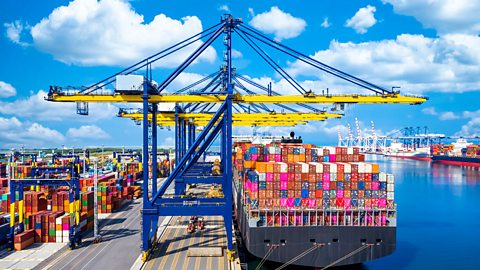What do you know?
How are different places connected through globalisation?
Globalisation connects place through transport and communications. People and goods can be transported to other places. People can communicate with those in other countries through phones and the internet.
Key points
- Transport and communications allow the flow of goodsThings that people can buy., labourPeople who work. and capitalMoney or wealth that can be invested. between countries.
- Transnational corporations (TNCsTransnational corporations. These companies operate in more than one country.) are companies that take advantage of global flowsThere are five different flows in globalisation: capital, labour, products, services and information. These flows are the reason globalisation exists. to operate in more than one country.
- globalisationThe process by which the world is becoming increasingly interconnected. has had a range of impacts.
What is globalisation?
Video: What is globalisation?
Learn about globalisation
What is globalisation?
Globalisation makes the world more connected. So how does it impact our everyday lives?
Most of my clothes are imported from places far away such as China, Vietnam and Bangladesh.
International trade means I can eat whatever I like whenever I like. For example, I don't have to wait for strawberries to be in season.
And technology like mobile phones and the internet allow me to call my family and use social media.
Large companies operate in a lot of different countries around the world.
Globalisation makes it easier to see family and friends. But it isn't all positive.
For example, transporting all the people, food and clothes around the world is polluting the environment.
And factory workers are sometimes low paid and work in poor conditions.
Globalisation is a complex issue but if we recognise how connected we are, we can understand each other better.
Globalisation
Globalisation is the process by which countries and people are becoming more connected. Improvements in transport and communicationsWays to send and receive information, for example the internet. enable people, goodsThings that people can buy., capitalMoney or wealth that can be invested. and information to move between countries.
As a result of globalisation, some corporations, or large companies, now operate in more than one country. These corporations are called TNCsTransnational corporations. These companies operate in more than one country. (transnational corporations).

Transnational corporations
TNCs have traditionally had their headquarters in the TriadThree centres within the world (the United States, Europe and Japan) that dominated the world economy up until the late 1990s. which is made up of the high income countries (HICs)Countries that have a high income, such as the UK and Japan. (high income countries) in Europe as well as the United States and Japan. Companies in the Triad have had an advantage as many of these countries were once colonial powerA country that uses its power to control another country. For example, Great Britain was a colonial power that ruled the British Empire.. Colonial powers grew richer through exploitedMaking use of resources, sometimes unfairly, in order to benefit from them. For example, colonial powers used their colonies’ resources in order to become wealthier. the resourceSomething of value due to its usefulness such as food, water or raw materials of their colonies. This wealth has enabled large companies to grow.
More recently, some MIC countries, such as China, have grown wealthier over time. These countries have become known as NEEsNewly emerging economies. Countries that are increasing their income, such as Nigeria and China. (newly emerging economies). This has led to larger companies and TNCs developing in these countries too.
TNCs often manufacture products in LICs or MICs where wagesPayment made to a person for carrying out a job. are lower. This allows them to make more profitMoney that is made from selling a product or service. from the productSomething that has been manufactured to sell. that they sell, but it can mean that workers in LICs are exploited Making use of people, sometimes unfairly, in order to benefit from their work. For example, some TNCs exploit workers by treating them badly or paying low wages.
The relocation of factories has led to industrialisationThe development of industries in a region or country. This may include the building of new factories for manufacturing so that countries can make more money. in many LICs and MICs and deindustrialisationWhen countries manufacture fewer products, leading to the closure of many factories. in many HICs.
Question
Why do you think HICs can now be found all over the world?
Globalisation has allowed countries to develop quickly due to an increase in trade, technology and skills. As a result, some countries such as Singapore have developed their manufacturing industry so effectively that is has become one of the most successful in the world.
Quiz: What is globalisation?
Impacts of globalisation
Globalisation has had both positive and negative impacts. Remember: not all the impacts listed here are equal. Some may be more serious than others.
Employment and resources

Job opportunities have led to economic growth in LICs and NEEs.
Deindustrialisation in HICs has led to job losses.
There is improved access to resources as countries trade with one another.
Some resources have been overexploited, which means they may run out.

Relationships and trade

Countries rely on one another and are more likely to work together.
Manufacturing and transportation processes can lead to higher levels of pollution.
Ideas and skills are shared between countries. This can lead to greater progress.
Unequal flows of people or capital can lead to some countries having less power. In some cases, TNCs are more powerful than the countries they operate in.

Question
Is globalisation a good thing?
Globalisation has advantages and disadvantages. Advantages include economic growth in LICs and NEEs, the sharing of ideas between countries and greater access to resources. Disadvantages include job losses in HICs, the overuse of resources and increased levels of pollution. In geography, it’s good to look at the question from different angles and realise there isn’t always a simple answer.
Quiz: Impacts of globalisation
Play the Planet Planners game! gamePlay the Planet Planners game!
Make decisions for the planet in this KS3 geography game.

More on Development and globalisation
Find out more by working through a topic
- count1 of 3

- count2 of 3
